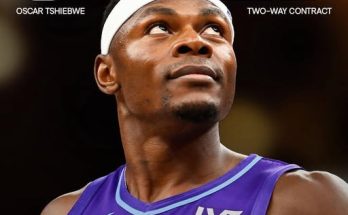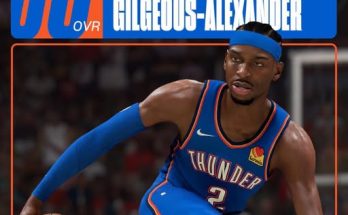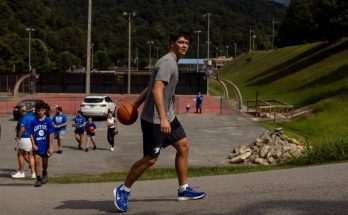Chaz Lanier’s name reverberated through the Barclays Center in Brooklyn on June 26, 2025, the moment the Detroit Pistons selected him with the No. 37 pick in the second round of the NBA Draft. In that single draft night moment, a story of transformation, grit, and pure shot-making arrived in the Motor City. For Detroit, emerging from a six-year playoff drought and seeking to sustain its resurgence, Lanier offered exactly what their evolving identity demanded: spacing, scoring, and maturity.
Lanier’s ascent to this moment could not have been more unconventional. Born December 19, 2001, in Nashville, Tennessee, Lanier cut his teeth at The Ensworth School before committing to the University of North Florida. There, across four seasons, he evolved from a reserve into a dynamic scorer, culminating in a breakout senior year where he averaged 19.7 points, 4.8 rebounds, and 1.8 assists per game—and shot a scorching 44 percent from beyond the arc . That year he was named First‑Team All‑ASUN and established himself as one of the nation’s top mid‑major scorers .
Yet Lanier’s journey didn’t stop in Jacksonville. In May 2024, he transferred to the University of Tennessee, stepping into the SEC spotlight under coach Rick Barnes . As a Volunteer, Lanier didn’t just shine—he redefined the role of a transfer guard. In 38 games, he posted 18.0 points, 3.9 rebounds, and 1.1 assists while preserving an efficient offensive profile (43.1/39.5/76 shooting splits) . More notably, he shattered Tennessee’s single‑season record with 123 made threes, the highest total since Chris Lofton’s 118 (. He earned First‑Team All‑SEC honors, the SEC Newcomer of the Year award, and took home the prestigious Jerry West Award as the country’s top shooting guard .
On draft night, Pistons President Trajan Langdon wasted no time in emphasizing the team’s direction. Detroit, coming off a 44–38 season and its first playoff appearance in six years, identified perimeter shooting as a key area to reinforce. With notable decisions looming on veterans Malik Beasley and Tim Hardaway Jr., a clear opening emerged for a shooter like Lanier . The fit was mutually beneficial: Detroit needed spacing for star Cade Cunningham and ball‑movement initiators like Jaden Ivey, while Lanier sought a destination ready to utilize his strengths .
Scouts and draft analysts lauded the pick. DetroitBetBreakdown called Lanier “a top shooting prospect” with a “true movement shooter” profile; he nailed 36 percent of his threes off the dribble last season—metronomic release, clutch demeano. Bleacher Report echoed this, likening him to Malik Beasley in terms of role and upside: “His special shotmaking and off‑ball skills should allow him to carve out a bench role in the right system.” They cautioned that he brings minimal play‑making or defense but emphasized his elite shooting efficiency and readiness .
Indeed, player comp comparisons materialized throughout: bigger, stronger Marcus Sasser; Malik Beasley; Gary Trent Jr.; Seth Curry—all accurate reflections of a player whose value is born in constant threat from three, solid size (6‑4 with a 6‑9 wingspan), and deft off‑ball movement .
Detroit’s front office, eager to complement Cunningham’s play-making and finishing prowess, saw Lanier as an affordable, low‑risk addition who could hit the ground running. As ESPN noted, “one of the Pistons’ biggest needs is perimeter shooting. To get Chaz Lanier at 37 is an excellent value” . ClutchPoints joined the praise, noting his instant shooting punch, high offensive polish, physical readiness, and maturity—though they flagged his age (24 as a rookie) as a possible ceiling limiter
At Tennessee during March Madness, Lanier dazzled in high-pressure moments, averaging over 20 points across four NCAA Tournament games, breaking out with 29 points against Wofford and propelling the Volunteers to the Elite Eight . That postseason performance underscored his poise and scoring mentality—a trait Detroit believes can fast-track his transition to professional minutes .
For Pistons fans, Lanier represents both a strategic move and personal intrigue. While he’s not expected to be a starter day one, he delivers a skillset tailor‑made for a bench scorer and floor spacer. Detroit’s revamped offseason already included signings of Caris LeVert and Duncan Robinson to shore up shooting, while they retained Paul Reed in the frontcourt . The addition of Lanier fits the blueprint: surround Cunningham with shooters who move intelligently and help space the floor.
That the Pistons used only one pick—37th overall—underscored their intent to be disciplined in asset accumulation and development. Michigan reports credited them for “doing an impressive job of adding shooting depth with veterans…and now…a standout shooting rookie with plenty of upside” .
For Lanier, the moment was emotional. News4JAX captured him reflecting on his arduous journey—“a long, unorthodox path…just a blessing”—highlighting his first‑ever selection as a former UNF player, something unheard of in Jacksonville . That narrative—underrated underclassman turned mid-major phenomenon turned SEC standout turned NBA draftee—resonates with anyone who cherishes perseverance.
Lanier himself spoke about the surreal nature of that moment when the Pistons called: “I was just super excited and grateful for the opportunity” . In welcoming him, Pistons social media greeted him with “Welcome to the 313, @Swaggychaz!”—a nod to the local culture and affirmation that Detroit sees him as part of its retrenchment and rebrand
Looking forward, Lanier’s challenge lies in converting his college excellence into NBA volume. His skill set—elite catch‑and‑shoot shooting, off‑screen cuts, spot‑up discipline—makes him immediately usable in high‑tempo lineups and bench units. His physical frame and wingspan give coaches confidence he can defend occasionally and hold up under NBA strain .
Critics point out his limited creation ability and defense, suggesting early growth may plateau. But Detroit’s roster—anchored by Cunningham’s scoring and play-making, Ivey’s energy, and spacing from LeVert, Robinson, Reed, and now Lanier—could hide his deficits and accentuate his strengths .
Moreover, Detroit’s commitment to a patient, developmental model—which values growth over splashy moves—is indicated by their veteran additions and the retention of their draft capital . Lanier fits precisely into this system: a polished late second-round selection, veteran presence, and ready-made rotational piece.
Detroit’s fanbase craves continuity and informed decisions. Lanier’s story—from North Florida grinder to SEC star to NBA draftee—checks the box on mythic underdog arcs, regular performance growth, and a dialed mentality. It’s the kind of narrative that energizes commitment to the franchise. In Pistons circles, hope is a scarce currency; Lanier’s presence feels earned.
As the Pistons progress into training camp and preseason, the plot will center on how quickly Lanier ingrains himself into rotations. Will he secure meaningful minutes as a 3-and-D role player? Can he shine off Cunningham’s play-making gravity? Address weaknesses—defensive assertiveness, shot-creation consistency? If yes, he’s well-positioned to carve out a multi-year role.
Detroit’s No. 37 pick may never headline highlight reels, but for a team rebuilding through maturation rather than one-time trades, Lanier fits like a puzzle piece. He bolsters their shooting lineage, reinforces developmental philosophy, and arrives with a quiet confidence rooted in real collegiate accomplishment. For Pistons faithful, he represents both a calculated bet and a testament to process.
For Lanier himself, the road is equally defined. As one of just a handful of UNF graduates drafted—and the first ever—that milestone already holds historical weight . Now he’ll aim to prove himself in Detroit, translating college accolades and shooting prowess into NBA viability.
Either it pays off—or Detroit has taken another tentative yet thoughtful step toward sustainable progress. In a league often consumed by fireworks and flash, Chaz Lanier arrives with no fanfare beyond his stroke. He’s here to shoot, he’s here to work, and he’s here because Detroit believes his type of growth story is worth both time and attention.
If all goes well, he’ll stress opponents, elevate lineups, and quietly reinforce the Pistons’ blueprint. If not, he still represents the kind of mid-round upside—a safe investment in a draft that yields few sure things. But to Detroit and his own story arc, pick No. 37 feels exactly right.



